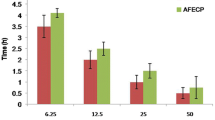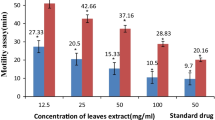Abstract
The anthelmintic potentials of the chloroform and methanol extracts of Buchholzia coriacea Engler seed were investigated. In folklore medicine, B. coriacea (Capparidaceae) is believed to be useful in the treatment of various kinds of ailments and diseases. At doses of 10 mg/kg, 25 mg/kg and 50 mg/kg, the extracts were tested against Eudrilus eugeniae (earthworm) and Bunostomum phlebotomum (cattle hookworm). The extracts exhibited dose-dependent anthelmintic effects on the earthworms and hookworms. The methanol extract at 50 mg/kg was the most active extract against the helminths, and the activity of the methanol extract was not significantly different from that of piperazine hydrate (reference drug, 10 mg/kg) against the earthworms.
Similar content being viewed by others
References
Adjanohoun JF, Aboubokar N, Dramane K, Ebot ME, Ekpere JA, Enow-Orock EG, Focho D, Gbile ZO, Kamanyi A, Kamsu-Kom J, Keita A, Mbenkum T, Mbi CN, Nkongmeneck B, Satabie B, Sofowora A, Tamze V, Wirmum CK (1996) Traditional medicine and pharmacopoeia: contribution to ethnobotanical and floristic studies in Cameroon. Organization of African unity, Scientific, Technical and Research Commission. Centre Nationale de Production des Manuels Scolaires, Porto-Novo, Benin, pp 207–209
Ajaiyeoba EO, Onocha PA, Olarenwaju OT (2001) In vitro anthelmintic properties of Buchholzia coriacea and Gynandropsis gynandra extract. Pharm Biol 39:217–20
Ajayeoba EO, Onocha PA, Nwozo SO, Sama W (2003) Antimicrobial and cytotoxicity evaluation of Buchholzia coriacea stem bark. Fitoterapia 74(7–8):706–709
Athnasiadou S, Kyriazakis I, Jackson F, Coop RL (2001) Direct anthelmintic effects of condensed tannins towards different gastrointestinal nematodes of sheep: in vitro and in vivo studies. Vet Parasitol 99:205–219
Burkill HM (1985) The useful plants of West Africa (tropical). Royal Botanic Gardens, Kew, 319
Dewanjee S, Maiti A, Kundu M, Mandal SC (2007) Evaluation of anthelmintic activity of crude extracts of Diospyros peregrine, Coccinia grandis and Schima wallichii. Dhaka Univ J Pharm Sci 6(2):121–123
Ezekiel OO, Onyeoziri NF (2009) Preliminary studies on the antimicrobial properties of Buchholzia coriacea (wonderful kola). Afr J Biotechnol 8(3):472–474
Girme AS, Bhalke RD, Ghogare PB, Tambe VD, Jadhav RS, Nirmal SA (2006) Comparative in vitro anthelmintic activity of Mentha piperita and Lantana camara from Western India. Dhaka Univ J Pharm Sci 5(1–2):5–7
Hutchinson J, Dalziel JM (1954) Flora of West tropical Africa. Crown Agents for Overseas Government and Administration, London, England, UK
Jinu J, Archana M, Shruti S, Pradeep M (2009) A report on anthelmintic activity of Cassia tora leaves. Songklanakarin J Sci Technol 31(3):1–3
Kameswara Rao B, Giri R, Kesavalu MM, Apparao CH (1997) Herbal medicine in the management of diabetes mellitus. Manphar Vaidhya Patrika 1:33–35
Mali GR, Hundiwale CJ, Sonawane SR, Patil NR, Hatapakki CB (2004) Evaluation of Capparis decidua for anthelmintic and antimicrobial activities. Ind J Nat Prod 20:10–3
Marles RJ, Farnsworth NR (1995) Antidiabetic plants and their active constituents. Phytomedicine 2:137–89
Mbata TI, Duru CM, Onwumelu HA (2009) Antibacterial activity of crude seed extracts of Buchholzia coriacea E. on some pathogenic bacteria. J Dev Biol Tissue Eng 1(1):001–005
Mehlhorn H, Al-Quraishy S, Al-Rasheid KAS, Jatzlau A, Abdel-Ghaffar F (2010) Addition of a combination of onion (Allium cepa) and coconut (Cocos nucifera) to food of sheep stops gastrointestinal helminthic infections. Parasitol Res. doi:10.10071300436-010-2169-3
Meregini AOA (2005) Some endangered plants producing edible fruits and seeds in South-eastern Nigeria. Fruits 60(3):211–220
Nweze NE, Fakae LB, Asuzu IU (2008) Anti-trypanosomal activity of the ethanolic extract of Buchholzia coriacea seeds. WOCMAP IV Book of Abstracts, Cape Town, South Africa, p 103
Nweze NE, Asuzu IU (2006) Antihelminthic effect of Buchholzia coriacea seeds. Niger Vet J 27(2):60–65
Nunomura RCS, Dasilva ECC, Oliverira DF, Garcia AM, Boeloni JN, Nunomura SM, Pohlit AM (2006) In vitro studies of the anthelmintic activity of Picrolemma sprucei Hook.f. (Simaroubaceae). Acta Amaz 36(3):327–330
Ojewole JA (2002) Hypoglycemic effect of Clausena anisata (Willd) Hook methanolic root extracts in rats. J Ethnopharmacol 81(2):231–237
Pierre D, Blaise K, Jean-Louis P (1973) Alcaloïdes chez les capparidaceae. Phytochemistry 12(12):2893–2895
Thompson DP, Geary TG (1995) The structure and function of helminth surfaces. In: Marr JJ (ed) Biochemistry and molecular biology of parasites, 1st edn. Academic, New York, pp 203–232
Trease GE, Evans WC (1996) Pharmacognosy, 14th edn. WB Saunders, London
Author information
Authors and Affiliations
Corresponding author
Rights and permissions
About this article
Cite this article
Fred-Jaiyesimi, A.A., Adepoju, A. & Egbebunmi, O. Anthelmintic activities of chloroform and methanol extracts of Buchholzia coriacea Engler seed. Parasitol Res 109, 441–444 (2011). https://doi.org/10.1007/s00436-011-2274-y
Received:
Accepted:
Published:
Issue Date:
DOI: https://doi.org/10.1007/s00436-011-2274-y




